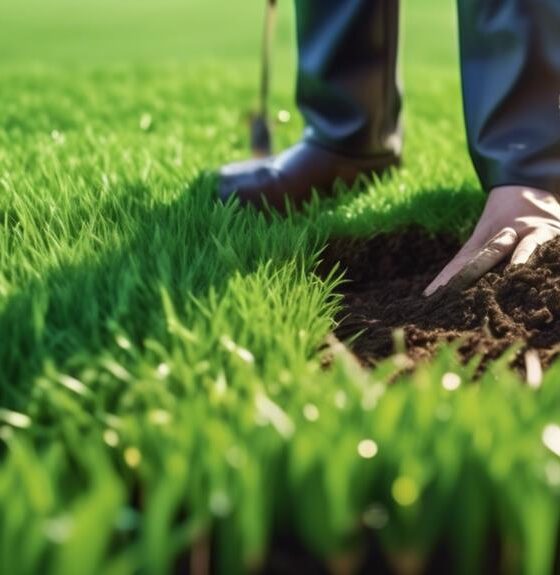Architecture Home Styles
Solving Common Roof Shingle Problems: A How-To Guide
Tackle the mysteries of roof shingle maintenance and discover expert tips to protect your home – your roof's future depends on it!
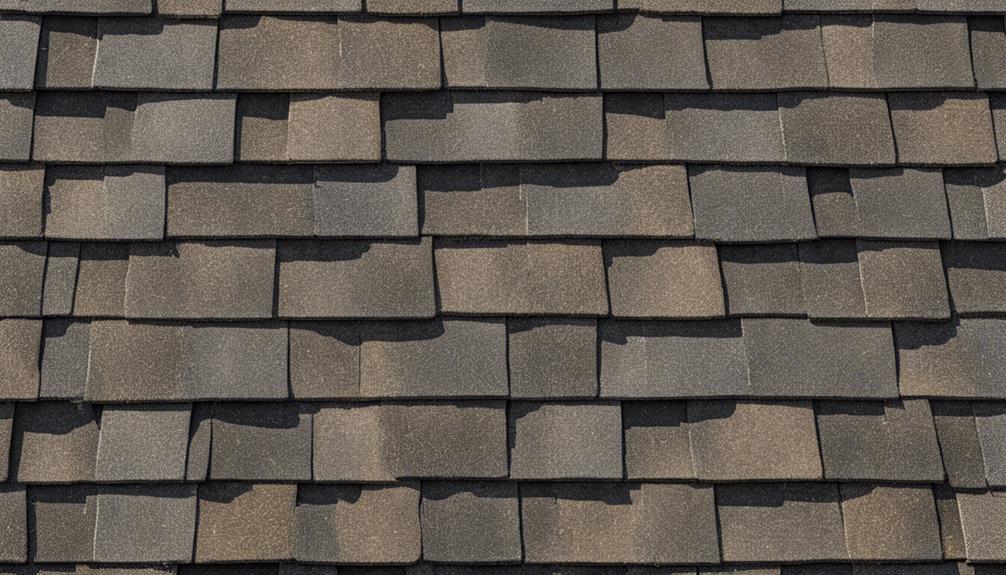
As we address the nuances of maintaining roof shingles, we uncover subtle yet significant challenges that homeowners may encounter. Understanding the intricacies of shingle damage is crucial, but what lies beyond identification is a practical roadmap to resolution that can safeguard your property from potential hazards.
Let's explore how mastering the art of shingle repair can not only save you money but also secure the longevity of your roof.
Key Takeaways
- Regular inspection is vital for early issue detection and prevention of leaks.
- Safety measures like proper gear and assistance are crucial during repairs.
- Identify damage, gather tools, remove and replace shingles carefully for effective repair.
- Maintain gutters, trim trees, ensure ventilation, and stay proactive for a healthy roof.
Signs of Roof Shingle Damage
Inspecting your roof regularly for signs of damage is crucial in maintaining its longevity and protecting your home from potential issues. When it comes to roof shingles, there are several key indicators of damage to watch out for. Missing shingles can pave the way for water leaks and interior damage, making it essential to address them promptly.
The presence of curled shingles may signal poor ventilation and underlying roof problems that need attention. Additionally, cracked shingles, often caused by temperature fluctuations and aging, can compromise the integrity of your roof. Keep an eye out for granule loss on shingles, as this can indicate aging and reduced protection for your roof.
Engaging in a visual inspection of your roof will enable you to identify these common shingle issues early on, preventing further damage and costly repairs down the road. Remember, proactive maintenance is key to preserving the health and durability of your roof.
Identifying Roof Shingle Damage

When identifying roof shingle damage, a quick visual scan can reveal common issues that may compromise the integrity of your roof. Here are three key signs to look out for:
- Missing Shingles: Inspect your roof for any gaps or areas where shingles are entirely absent. Missing shingles can leave your roof vulnerable to water infiltration and indicate issues with the installation or severe weather conditions.
- Curled Shingles: Keep an eye out for shingles that are curling at the edges. Curling can be caused by factors like sunlight exposure, poor ventilation, or installation problems. Curled shingles are more prone to damage and may need repair to prevent further issues.
- Cracked Shingles: Check for any shingles with visible cracks. Cracks can develop due to weather exposure, aging, or physical impact, leading to potential water leaks. Addressing cracked shingles promptly is essential to maintain the protection of your roof and prevent further damage to the roofing materials.
Causes of Roof Shingle Damage
Extreme weather conditions, critters, and poor attic ventilation are among the primary culprits behind roof shingle damage. Weather elements like hail, wind, and heat can cause significant harm to shingles, leading to cracks and breakage. Critters such as birds and squirrels may peck or chew at the shingles, causing damage over time. Inadequate attic ventilation can result in heat and moisture buildup, accelerating the deterioration of shingles. Tree branches that rub against the roof during windy conditions can cause wear and tear on the shingles, reducing their lifespan.
To help you understand the causes of roof shingle damage more clearly, here's a table summarizing the main culprits:
| Causes | Description | Prevention |
|---|---|---|
| Extreme Weather | Hail, wind, and heat can lead to cracks and breakage in shingles. | Regular roof inspections |
| Critters | Birds and squirrels may peck or chew at shingles, causing gradual damage. | Secure attic access |
| Poor Attic Ventilation | Inadequate ventilation accelerates shingle deterioration due to heat/moisture buildup. | Ensure proper ventilation |
Understanding these causes will help you take proactive steps to prevent roof shingle damage and ensure the longevity of your roofing system.
Safety Considerations for Repair
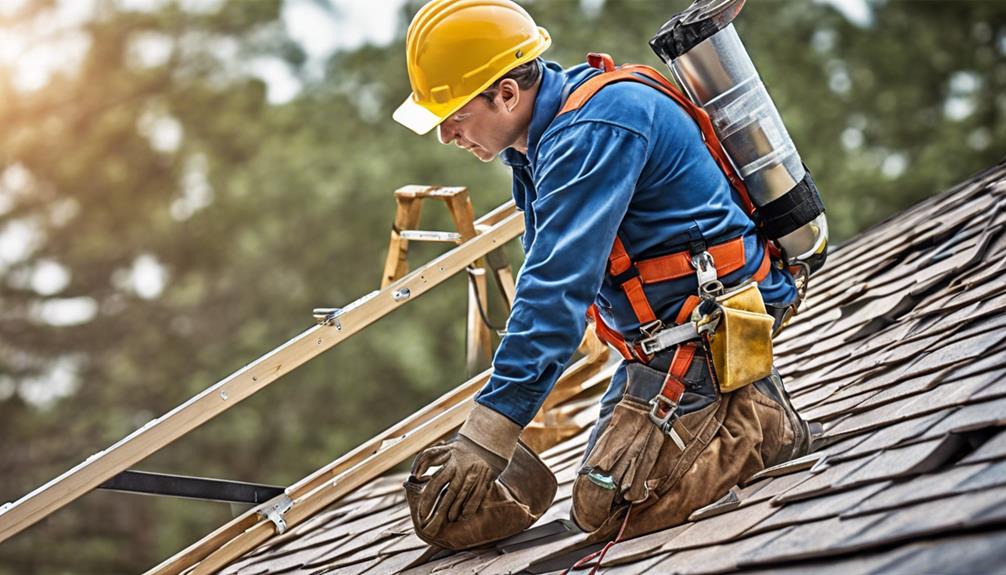
To ensure a safe and successful roof shingle repair, it's crucial to prioritize the necessary safety precautions, such as wearing safety harnesses and hard hats to prevent falls and injuries. Here are three key safety considerations to keep in mind:
- Proper Shoes: It's essential to wear shoes with good traction to avoid slipping on the roof while working. This simple step can significantly reduce the risk of accidents and injuries during the repair process.
- Working with a Partner: Having a partner present can provide additional support and assistance during roof shingle repairs. They can help with handing tools, holding ladders steady, or even provide help in case of an emergency.
- Professional Help for Steep Roofs: For steep roofs, consider seeking professional help. Experts are trained to handle challenging roof repairs safely and efficiently, ensuring that the job is done right without putting anyone at risk.
Prioritizing safety measures like these is crucial for fall prevention and expert handling of roof shingle repairs.
Step-by-Step Repair Instructions
In repairing roof shingles, start by identifying any damaged areas exhibiting signs like curling, cracking, or missing shingles. Once you've located the problematic shingles, gather your tools – a pry bar, roofing cement, roofing nails, and replacement shingles.
Carefully remove the damaged shingles by lifting the tabs and extracting the nails with precision. Next, replace the damaged shingles with new ones, ensuring a secure fit by fastening them with roofing nails.
To finish the repair, apply roofing cement to the edges of the new shingles to create a watertight seal that will protect your roof from further damage. By following these step-by-step instructions, you can effectively fix issues like curling or cracked shingles, restoring the integrity of your roof and ensuring its longevity.
Frequently Asked Questions
How Do You Fix Shingles That Are Lifting?
When shingles are lifting, we fix them by applying roofing sealant underneath and pressing down firmly for adhesion. Use a caulking gun for precise application to prevent further lifting.
Make sure the shingle aligns properly with surrounding ones for a seamless look. Monitor the repair periodically for any re-lifting signs.
It's crucial to act promptly to prevent water damage and maintain the integrity of your roof.
How Do You Repair a Section of Shingles?
When repairing a section of shingles, we start by identifying the damaged area and carefully lifting the tabs to access the nails. Using a pry bar, we remove the nails securing the damaged shingles.
After discarding the old shingles, we replace them with new ones of the same type and color. Securing the new shingles in place with nails and roofing cement provides added protection.
This process ensures a durable and visually appealing repair job.
How Do You Match Roof Shingles for Repair?
When matching roof shingles for repair, we select the same color, style, and material to ensure uniformity. It's vital to find replacement shingles with matching dimensions and thickness for a seamless look.
We always consider buying extra shingles to prepare for future repairs and potential color variations. Sourcing replacement shingles from the same manufacturer guarantees compatibility and quality, preserving the roof's aesthetic appeal and overall integrity.
How Do You Fix Curled Shingles on a Roof?
When shingles curl on a roof, we tackle the issue head-on. Apply sealant under the curled corners, then press down with a heavy object until it dries.
To reinforce the fix, glue the edges to prevent future curling. When adding new shingles, align them precisely with the existing ones for a uniform look. Use a caulking gun for precise application of sealant.
These steps ensure a sturdy and visually appealing repair.
Conclusion
In conclusion, identifying and solving common roof shingle problems is crucial for maintaining the integrity of your roof. By addressing issues like curling, cracking, or missing shingles promptly, you can prevent further damage and costly repairs down the line.
Remember, a stitch in time saves nine when it comes to roof maintenance. Stay proactive, stay informed, and your roof will thank you for it in the long run.
- About the Author
- Latest Posts
Introducing Ron, the home decor aficionado at ByRetreat, whose passion for creating beautiful and inviting spaces is at the heart of his work. With his deep knowledge of home decor and his innate sense of style, Ron brings a wealth of expertise and a keen eye for detail to the ByRetreat team.
Ron’s love for home decor goes beyond aesthetics; he understands that our surroundings play a significant role in our overall well-being and productivity. With this in mind, Ron is dedicated to transforming remote workspaces into havens of comfort, functionality, and beauty.
Architecture Home Styles
Where Did Neo Traditional Tattoos Come From? Explained in Detail
Step into the rich history of Neo Traditional tattoos, a mesmerizing fusion of cultures and art forms that shaped a new era in tattooing.

We all know tattoos have been around for centuries, but have you ever wondered where the vibrant and intricate Neo Traditional style originated from?
The journey of Neo Traditional tattoos takes us back to the bustling streets of late 1970s New York City, where a fusion of influences sparked a revolution in the tattooing world.
Stay tuned as we uncover the fascinating blend of traditional Japanese irezumi and American folk art that gave birth to this captivating tattoo style, influencing artists worldwide.
Key Takeaways
- Neo Traditional tattoos originated in late 1970s NYC, blending American and Japanese styles.
- Influenced by American folk art, pop culture, and diverse cultural inspirations.
- Evolution from traditional American tattooing with vibrant colors and intricate designs.
- Symbols like animals, flowers, skulls, and mythical creatures convey deep meanings in designs.
Origins of Neo Traditional Tattoos
How did the neo traditional tattoo style emerge and evolve from its roots in late 1970s New York City?
Neo traditional tattooing began as a modern interpretation of the classic American traditional style. Drawing inspiration from traditional Japanese tattoo art, neo traditional tattoos incorporate elements like bold lines, vibrant colors, and intricate designs. This evolution allowed artists to push boundaries beyond the constraints of traditional tattoos, exploring new techniques and styles.
Influenced by American folk art, pop culture, and the art deco movement, neo traditional tattoos showcase a unique blend of old-school charm and contemporary flair. Skilled traditional tattoo artists transformed animals, flowers, nature scenes, and pop culture references into stunning pieces of body art, characterized by their vivid colors and bold outlines.
The neo traditional style's fusion of traditional and modern aesthetics has captivated tattoo enthusiasts seeking innovative and visually striking designs.
Influences on Neo Traditional Style

In tracing the influences on the neo traditional style, we delve into a rich tapestry of traditional American tattooing from the early 20th century, where modern elements seamlessly intertwine with classic motifs to create a vibrant and symbolically significant art form. The traditional American style, with its bold lines and iconic imagery, serves as the foundation for neo traditional tattoos, which elevate these elements with a contemporary flair. Neo traditional artists infuse designs with modern techniques like vivid colors, intricate shading, and intricate detailing, breathing new life into traditional symbols.
Drawing inspiration from diverse cultures such as Native American, Celtic, Hindu, and African, neo traditional tattoos incorporate a wide range of symbols like wolves, bears, and birds to convey attributes like strength, courage, and wisdom. These designs hold personal significance for individuals, reflecting their values and beliefs through a fusion of historical influences and modern interpretations. The evolving nature of neo traditional style continues to captivate tattoo enthusiasts seeking innovative and meaningful body art.
Evolution of Neo Traditional Tattoos
The transformation of traditional American tattooing in the late 20th century birthed the evolution of Neo Traditional tattoos. This style takes classic motifs and injects them with a modern twist, incorporating vibrant colors, detailed designs, and intricate shading.
Neo Traditional tattoos distinguish themselves with bold lines, dynamic compositions, and a broad color palette that allows for artistic expression and depth. Drawing inspiration from various cultures, these tattoos often hold personal significance for individuals, representing aspects of their lives, beliefs, or experiences.
The infusion of cultural elements and symbolism adds layers of meaning to these tattoos, making them not just aesthetically pleasing but also deeply reflective of the wearer's identity. The evolution of Neo Traditional tattoos showcases a harmonious blend of tradition and innovation, creating a visually stunning and emotionally resonant art form that continues to captivate both tattoo enthusiasts and artists alike.
Symbolism in Neo Traditional Tattoos

Symbolism plays a crucial role in Neo Traditional tattoos, imbuing each design with layers of meaning and significance that resonate deeply with the wearer. In these tattoos, various symbols are used to convey messages of strength, wisdom, and courage. Animals like wolves and bears often represent strength, while flowers and botanical elements symbolize beauty, growth, and femininity. Birds can embody notions of freedom, spirituality, and the journey of life. Skulls, on the other hand, are commonly associated with mortality, change, and the cycle of life. Mythical creatures such as dragons or unicorns bring in elements of power, magic, and fantasy to the designs.
| Symbol | Meaning |
|---|---|
| Wolves | Strength |
| Flowers | Beauty, Growth, Femininity |
| Birds | Freedom, Spirituality, Life's Journey |
| Skulls | Mortality, Change, Cycle of Life |
| Mythical Creatures | Power, Magic, Fantasy |
Future Trends in Neo Traditionalism
Exploring the realm of future trends in neo traditionalism reveals exciting possibilities for the evolution of color palettes and shading techniques, as well as the exploration of new subject matters and themes by artists. Here are three key areas to watch for in the future of neo traditional tattoos:
- Innovative Color Palettes: Artists may push boundaries by incorporating unconventional color schemes and gradients, adding depth and dimension to traditional designs.
- Advanced Shading Techniques: With advancements in tattoo technology, we can anticipate more intricate and realistic shading techniques, creating lifelike textures and effects in neo traditional pieces.
- Collaborative Projects: Collaboration between tattoo artists and professionals from other creative fields, such as fashion or graphic design, could lead to unique fusion styles and fresh interpretations of neo traditional themes.
As the tattoo industry continues to evolve, embracing experimentation, new technologies, and interdisciplinary collaboration, the future of neo traditional tattoos promises to be a vibrant tapestry of innovation and creativity.
Frequently Asked Questions
Where Did Traditional Tattoos Originate?
Traditional tattoos originated among sailors and blue-collar workers in the mid-20th century. They featured bold lines, limited colors, and 2-dimensional imagery. The first electric tattoo machine, patented in 1891, influenced their evolution.
What Does Neo Traditional Tattoo Mean?
Neo Traditional tattoos signify a fusion of classic American tattoo styles with contemporary artistry. They boast bold outlines, intricate designs, and a vibrant color palette, reflecting a modern take on traditional motifs. This style showcases creativity and versatility.
What Are the Rules for Neo Traditional?
We adhere to traditional tattoo rules with bold outlines and vibrant colors. Our style, inspired by Art Nouveau and Art Deco, showcases intricate details and exotic influences. Neo traditional tattoos often feature animals, women, and ornate elements.
Do Neo Traditional Tattoos Age Well?
Absolutely, neo traditional tattoos age well thanks to their bold outlines and vibrant colors. The intricate detailing and proper aftercare play a crucial role. Touch-ups may be needed, but with skilled artists and care, these tattoos retain their beauty.
Conclusion
In conclusion, Neo Traditional tattoos have come a long way since their origins in 1970s New York City, blending Japanese and American tattooing traditions into a vibrant and versatile style.
As of today, Neo Traditional tattoos account for over 25% of all tattoo designs requested worldwide, showcasing their enduring popularity and influence in the tattooing community.
With their bold colors, intricate detailing, and diverse imagery, Neo Traditional tattoos continue to captivate both artists and enthusiasts alike.
- About the Author
- Latest Posts
Introducing Ron, the home decor aficionado at ByRetreat, whose passion for creating beautiful and inviting spaces is at the heart of his work. With his deep knowledge of home decor and his innate sense of style, Ron brings a wealth of expertise and a keen eye for detail to the ByRetreat team.
Ron’s love for home decor goes beyond aesthetics; he understands that our surroundings play a significant role in our overall well-being and productivity. With this in mind, Ron is dedicated to transforming remote workspaces into havens of comfort, functionality, and beauty.
Architecture Home Styles
How Wooden Houses Are Preferred in Japan: a Guide
Step into the enchanting world of Japanese architecture through the timeless allure and cultural significance of wooden houses – a captivating journey awaits!
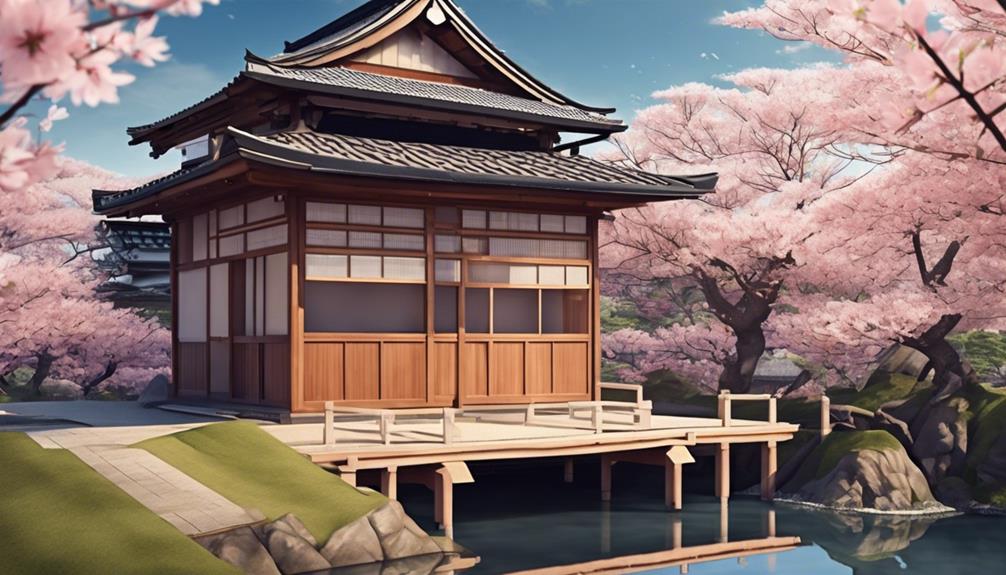
As we navigate the intricate world of Japanese architecture, one cannot overlook the deep-rooted tradition of wooden houses in the Land of the Rising Sun.
The allure of these structures goes beyond mere aesthetics; it encompasses a profound cultural significance that beckons exploration into the very essence of Japanese craftsmanship and design philosophy.
But what makes wooden houses the preferred choice in Japan, and how do they continue to captivate the imagination of architects and homeowners alike?
Let's uncover the layers of this timeless preference and discover the secrets that lie within Japan's wooden architectural wonders.
Key Takeaways
- Traditional wood construction in Japan offers superior thermal insulation and cost reduction benefits.
- Japanese woodworking techniques ensure precision and earthquake resistance in wooden houses.
- Modern wooden houses in Japan combine traditional craftsmanship with contemporary design for sustainability.
- Collaborating with architects enhances the functionality, aesthetics, and structural integrity of wooden houses.
Reasons for Preference in Japan
The preference for wooden houses in Japan stems from a combination of historical traditions, modern advancements, and practical benefits that have shaped the country's architectural landscape. Japanese traditional wood construction techniques not only offer excellent moisture control and heat insulation but also provide a sense of comfort unmatched by other materials. This emphasis on comfort has made wooden houses a staple in Japan, with over 90% of detached houses being constructed using wood due to its superior thermal insulation properties.
Moreover, wooden houses in Japan offer significant cost reduction benefits when compared to reinforced concrete or steel construction methods. The ability to easily renovate or demolish traditional wooden structures allows for a high degree of design freedom, appealing to those seeking innovative architectural solutions. With advancements in new wooden construction techniques, the popularity of wooden houses in Japan continues to grow, showcasing a harmonious blend of tradition and modernity in architecture.
Construction Methods in Japan
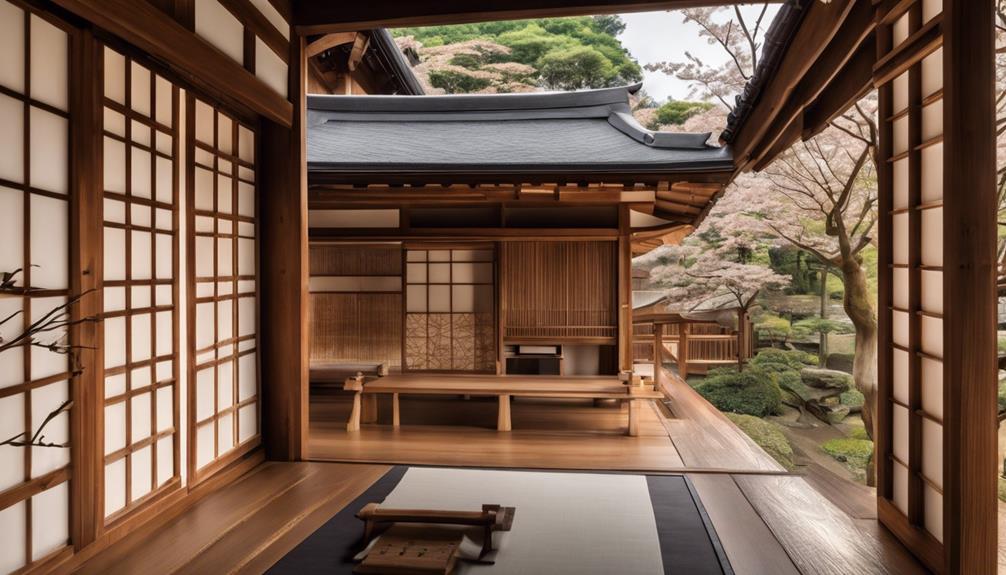
Exploring the construction methods employed in Japan sheds light on the intricate framework systems and innovative techniques utilized in traditional wooden house building. Japanese woodworking techniques have been honed over centuries, emphasizing precision and craftsmanship in constructing wooden structures. The traditional Japanese approach involves a framework system consisting of posts and beams carefully assembled to create sturdy wooden houses. Additionally, the introduction of the two-by-four system from North America has revolutionized wooden construction in Japan, providing systematized components that result in cost and time savings during the building process.
One significant advantage of wooden construction in Japan is its earthquake resistance. Through meticulous design and the use of appropriate building materials, wooden houses are engineered to withstand seismic activities effectively. Moreover, the incorporation of deep eaves in traditional Japanese architecture not only adds to the aesthetic appeal but also serves practical purposes such as protecting the wooden structure from the elements.
Unique Characteristics of Wooden Houses
Delving into the realm of wooden houses in Japan unveils a myriad of unique characteristics that distinguish them from other types of construction.
- High Thermal Insulation and Comfort: Japanese housing, especially wooden houses, excel in providing excellent thermal insulation and comfort due to the use of natural materials like wood. This ensures a cozy living environment throughout the year, maintaining warmth in winter and coolness in summer.
- Cost-Effectiveness: Wooden houses in Japan are known for being cost-effective compared to structures made of reinforced concrete or steel. This affordability makes them a popular choice among homeowners and contributes to their widespread use in the country.
- Design Freedom and Durability: Wooden houses offer a high degree of design freedom, allowing architects and homeowners to create unique and innovative structures. Additionally, advancements in construction techniques have enhanced the durability of wooden houses, ensuring they stand the test of time while providing a comfortable and sustainable living space.
Modern Wooden House Examples
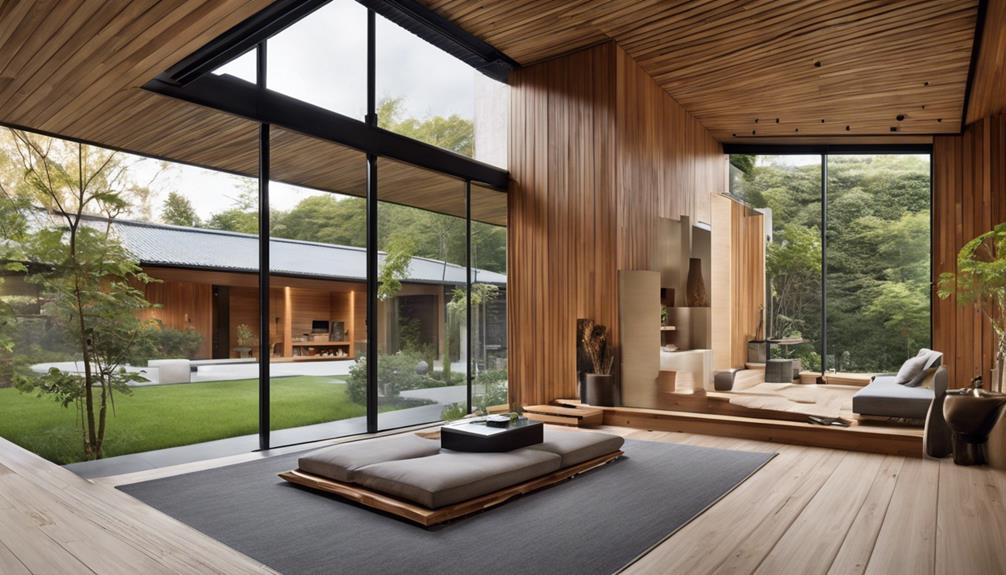
Within the realm of modern wooden architecture in Japan, a fusion of traditional craftsmanship and contemporary design principles creates captivating and sustainable living spaces. Japanese homes exemplify this blend, showcasing innovative use of wood in sustainable and energy-efficient construction practices. Architects in Japan skillfully combine traditional techniques with modern design elements to create unique wooden houses that feature open floor plans, large windows, and eco-friendly design principles. These modern wooden houses not only prioritize aesthetics but also emphasize functionality and environmental consciousness.
Below are examples of modern wooden houses in Japan that highlight the harmonious balance between traditional techniques and contemporary design:
| House Name | Architect |
|---|---|
| 'Wooden Harmony' | Yui Architects |
| 'Nature's Embrace' | Sato Architecture |
| 'Zen Modernity' | Nakamura Designs |
These houses are renowned for their use of natural materials, energy-efficient construction, and seamless integration of wood into modern living spaces, reflecting Japan's commitment to sustainable and innovative architectural practices.
Benefits of Building With Architects
In the realm of modern wooden architecture in Japan, the collaboration with architects brings forth a multitude of benefits that enhance the design, functionality, and sustainability of wooden houses.
- Architects with proven track records: Experienced architects in Japanese building practices bring a wealth of knowledge and skill to the table, ensuring that the wooden house isn't only visually appealing but also structurally sound.
- Compliance with regulations: Architects navigate the complex web of building codes and regulations, guaranteeing that the wooden house meets all necessary standards for a safe and secure living environment.
- Innovative solutions for sustainable living: Architects offer innovative solutions to maximize the use of space, harness natural light, and improve energy efficiency within wooden house designs. Their expertise leads to environmentally friendly homes that align with modern sustainability goals.
Frequently Asked Questions
Why Are Wooden Houses Preferred in Japan?
We choose wooden houses in Japan for several reasons. High thermal insulation and comfort from natural materials are key factors. Cost reduction plays a significant role compared to concrete or steel. New construction techniques enhance efficiency.
The flexibility in design, ease of renovation, and excellent heat insulation are all appealing features. These combined aspects make wooden houses a preferred choice for many in Japan.
Why Is Wood Important in Japanese Culture?
Wood holds a unique significance in Japanese culture, stemming from its rich history and multifaceted uses. From architectural marvels to everyday items, wood embodies tradition, sustainability, and craftsmanship.
Its deep ties to Shinto beliefs and the natural world reinforce its importance in Japanese society. How could a material so versatile and symbolic not play a central role in shaping the cultural identity of a nation?
What Is the Wood Architecture in Japan?
Wood architecture in Japan is a unique blend of tradition and innovation. From post-and-beam systems to two-by-four construction, wood is extensively utilized for its flexibility, sustainability, and cultural significance.
With approximately 90% of single-family houses in Japan built using wood, it's evident that wooden architecture is favored for its easy renovation, cost efficiency, and excellent insulation properties.
Advancements in construction techniques continue to enhance the comfort and affordability of wooden houses.
What Wood Are Traditional Japanese Houses Made Of?
In traditional Japanese houses, the primary woods used are softwoods like Hinoki false cypress, Japanese cedar, and Japanese red pine. These woods are selected for their durability, flexibility, and resilience to natural elements.
Hinoki false cypress, for example, is valued for its insect-repellent properties and pleasant scent. Japanese cedar's strength and straight grain make it perfect for structural components. Meanwhile, Japanese red pine, known for its beauty and resistance to decay, is suitable for various applications in traditional Japanese construction.
Conclusion
In conclusion, why wouldn't anyone choose the charm and practicality of wooden houses in Japan?
With a rich history, sustainable materials, and innovative construction methods, these structures stand the test of time.
From their resilience to earthquakes to their adaptability to changing seasons, wooden houses embody a cultural heritage that continues to inspire modern architecture.
So, next time you consider building your dream home, why not embrace the tradition and craftsmanship of a Japanese wooden house?
- About the Author
- Latest Posts
Introducing Ron, the home decor aficionado at ByRetreat, whose passion for creating beautiful and inviting spaces is at the heart of his work. With his deep knowledge of home decor and his innate sense of style, Ron brings a wealth of expertise and a keen eye for detail to the ByRetreat team.
Ron’s love for home decor goes beyond aesthetics; he understands that our surroundings play a significant role in our overall well-being and productivity. With this in mind, Ron is dedicated to transforming remote workspaces into havens of comfort, functionality, and beauty.
Architecture Home Styles
How to Decide if Buying a House Built in 1960 Is OK
Leverage expert advice to uncover the hidden risks and rewards of purchasing a 1960s house – your retro dream might need a reality check!

So, you're considering purchasing a house from the swinging sixties, huh?
Well, before you make that final decision, let's talk about some crucial factors to weigh in.
From potential electrical hazards to hidden plumbing issues, there's more to that retro charm than meets the eye.
But hold on, we've got some insightful tips to help you navigate through the maze of decisions when it comes to investing in a mid-century gem.
Key Takeaways
- Assess structural integrity, maintenance needs, and potential upgrades for long-term investment viability.
- Consider energy efficiency upgrades like insulation, windows, and HVAC systems for cost savings and comfort.
- Address environmental hazards like lead paint and asbestos through professional assessment and mitigation.
- Understand market trends, resale value factors, and seek real estate advice for informed decision-making.
Age and Structural Integrity
When considering a house built in 1960, it's essential to assess its age and structural integrity to make an informed decision on its potential as a long-term investment. Homes constructed in the 1960s often boast solid structural foundations, with features like hardwood floors contributing to their durability.
The presence of hardwood floors not only adds aesthetic value but also enhances the structural integrity of the house. Additionally, the electrical system in homes from this era, typically requiring around 100 amps of electricity, is usually well-built, further solidifying the structural soundness of the property.
1960s homes are known for their robust construction, and the incorporation of hardwood floors, along with decent wiring and plumbing, indicates a reliable investment. These factors make houses from this era appealing to buyers looking for a sturdy and enduring property, showcasing the importance of assessing the structural integrity when contemplating the purchase of a 1960s home.
Renovation and Maintenance Considerations
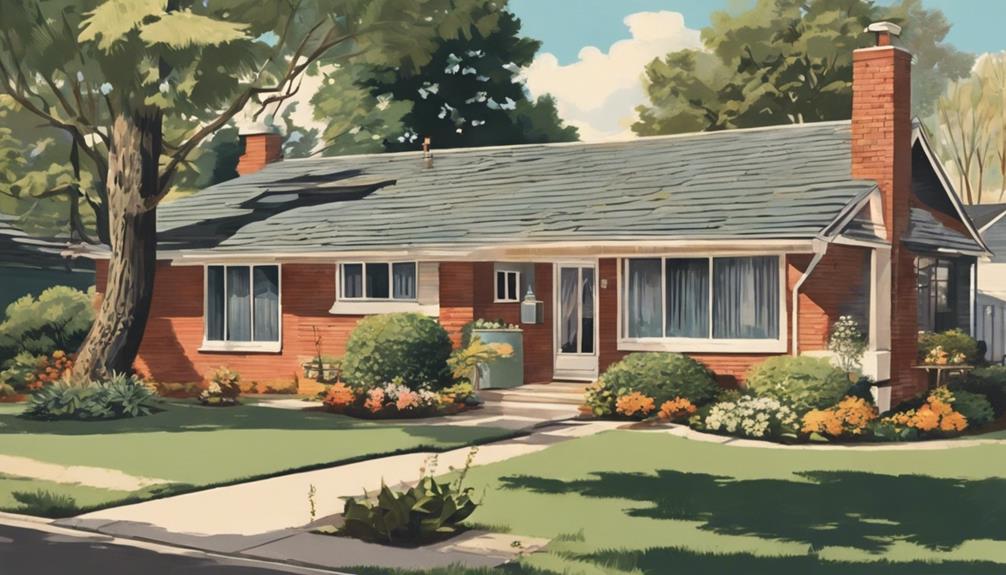
Considering renovation and maintenance considerations for a house built in the 1960s, it is crucial to evaluate the potential updates required to ensure modern functionality and efficiency. When assessing a property from this era, attention should be given to the electric service, plumbing systems, insulation, window upgrades, regular maintenance, and potential updates. Here is a breakdown of key factors to consider for a 1960s home:
| Aspect | Description | Importance |
|---|---|---|
| Electric Service | Upgrading the electrical system to meet modern demands ensures safety and capability for new devices. | High |
| Plumbing Systems | Aging pipes and materials in plumbing systems may need attention to prevent issues and ensure efficiency. | Moderate |
| Insulation | Enhancing insulation can significantly improve energy efficiency and comfort levels in the home. | High |
| Window Upgrades | Upgrading windows can enhance energy efficiency, reduce noise, and improve the overall aesthetics. | Moderate |
| Regular Maintenance | Regular upkeep is essential to prevent costly repairs and maintain the property's value. | High |
Addressing these aspects through maintenance and updates can help transform a 1960s house into a modern, efficient living space.
Energy Efficiency and Upgrades
To enhance the energy efficiency of a house built in the 1960s, consider upgrading insulation, windows, and doors to reduce utility costs and improve overall performance. Homes constructed in the 1960s often lack modern energy-saving features like double-pane windows and adequate insulation, leading to higher utility expenses.
By investing in upgrades such as improved insulation and energy-efficient windows and doors, you can significantly enhance the energy efficiency of a 1960s home. Additionally, replacing older heating and cooling systems with more efficient models can further contribute to energy conservation and lower utility bills.
Upgrading to energy-efficient appliances and HVAC systems can elevate the overall energy performance of the property, increasing comfort levels and potentially boosting its resale value. These enhancements not only make your home more environmentally friendly but also align it with contemporary energy efficiency standards, providing a more sustainable living environment while reducing long-term utility costs.
Environmental Concerns
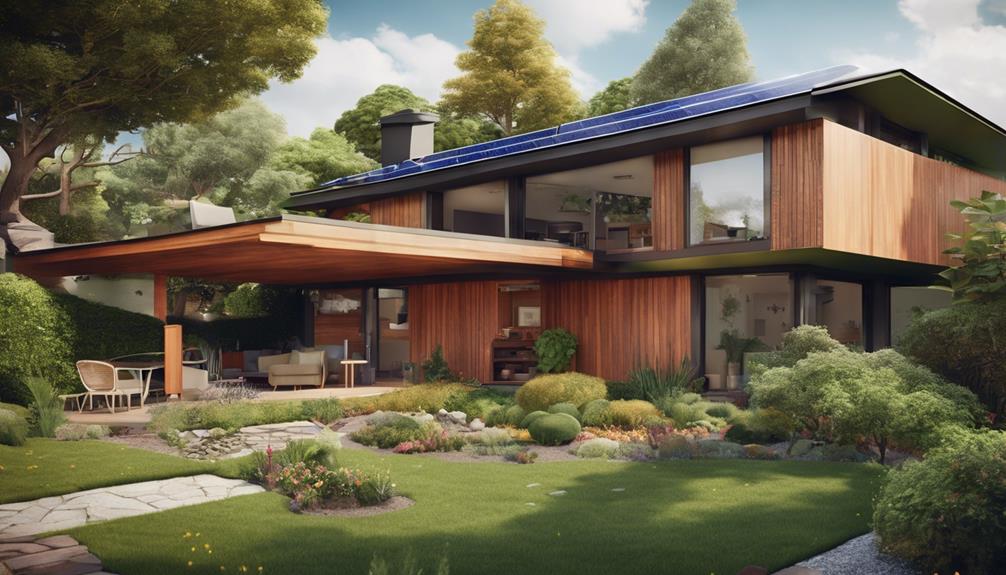
Older homes constructed in the 1960s may present environmental concerns, notably the presence of lead paint and asbestos requiring meticulous handling and maintenance. While these issues can seem daunting, with proper management, they can be addressed effectively.
- Lead Paint: Homes built in the 1960s often used lead paint, which can pose health risks, especially to children. Regular maintenance and encapsulation methods are crucial to minimize exposure and ensure a safe living environment.
- Asbestos: Asbestos, commonly found in older homes, including those from the 1960s, requires careful handling. Professional assessment and proper maintenance can help mitigate the risks associated with asbestos exposure.
- Environmental Concerns: Being aware of these environmental hazards in homes constructed in the 1960s is essential. By staying informed and taking proactive measures, such as regular inspections and maintenance, you can enjoy the benefits of owning a vintage home while ensuring a healthy indoor environment for you and your family.
Resale Value and Market Trends
Aware of the environmental concerns associated with older homes from the 1960s, it's crucial to now explore the resale value and market trends of such properties. Houses constructed in the 1960s often boast features that contribute to their solid resale value, such as copper plumbing and hardwood floors. Market trends indicate a growing demand for well-maintained 1960s homes, as buyers appreciate the quality construction and unique character they offer.
Factors like location, condition, and any upgrades can significantly impact the resale value of a 1960s house. Understanding local market trends and buyer preferences is essential in determining the resale potential of such properties. Collaborating with a real estate professional can provide valuable insights into the current market demand for houses from the 1960s, helping prospective buyers make informed decisions.
Frequently Asked Questions
Is It OK to Buy a House Built in 1960?
Absolutely! Buying a house built in 1960 can be a fantastic choice. These homes often feature sturdy construction, copper plumbing, and hardwood floors that add value and character.
With upgrades, you can modernize while preserving the charm of the era. The wiring and electrical setup are typically sufficient for today's needs.
What to Look for in a House Built in 1960?
When considering a house from the 1960s, it's important to look for specific features that can impact the home's quality and value. Key elements to check include:
- Copper plumbing, which is known for its durability and longevity.
- Decent wiring to ensure the safety and efficiency of the electrical system.
- 100-amp electrical service to meet the modern electrical needs of a household.
Additionally, it's essential to inspect the interior features of the house, such as:
- Hardwood floors, which are not only aesthetically pleasing but also durable and easy to maintain.
- Wall-to-wall carpeting can provide added protection to the floors and insulation to the rooms.
Lastly, assessing the overall construction strength of the home is crucial for ensuring its longevity and structural integrity. These features play a significant role in determining the suitability and value of a 1960s house.
What Style of Homes Were Built in the 1960s?
In the 1960s, various home styles emerged, reflecting the era's architectural trends. Mid-century modern homes boasted clean lines and open layouts.
Ranch-style houses featured single-story designs with horizontal elements. Split-level homes offered staggered floors for functional living spaces.
Colonial-style residences showcased traditional symmetrical facades with classic details. Contemporary homes embraced innovative features like large windows and unique shapes.
These diverse styles from the 1960s continue to inspire modern architecture.
What Is the Oldest Age You Should Buy a House?
When considering the oldest age for buying a house, factors like maintenance, updates, and construction quality are crucial. Older homes, around 60 years old, may require more upkeep than newer builds.
It's essential to thoroughly inspect and assess the property before deciding. Careful evaluation will help us determine if a house from 1960 is a suitable investment.
Conclusion
In conclusion, purchasing a house built in 1960 can be like uncovering a hidden gem – full of character and potential, but requiring some polishing and TLC.
By carefully evaluating the age and structural integrity, considering renovation and maintenance needs, prioritizing energy efficiency upgrades, addressing environmental concerns, and keeping an eye on resale value and market trends, you can turn an older home into a timeless treasure.
Happy house hunting!
- About the Author
- Latest Posts
Introducing Ron, the home decor aficionado at ByRetreat, whose passion for creating beautiful and inviting spaces is at the heart of his work. With his deep knowledge of home decor and his innate sense of style, Ron brings a wealth of expertise and a keen eye for detail to the ByRetreat team.
Ron’s love for home decor goes beyond aesthetics; he understands that our surroundings play a significant role in our overall well-being and productivity. With this in mind, Ron is dedicated to transforming remote workspaces into havens of comfort, functionality, and beauty.
-

 Vetted3 weeks ago
Vetted3 weeks ago15 Best Contact Paper for Kitchen Cabinets to Elevate Your Home Decor
-

 Vetted2 weeks ago
Vetted2 weeks ago15 Best Poe Cameras for Home Security – Reviews & Buying Guide
-

 Vetted4 weeks ago
Vetted4 weeks ago15 Best Leather Restorer Products to Revive Your Furniture and Accessories
-

 Vetted3 weeks ago
Vetted3 weeks ago15 Best Drain Snakes to Unclog Your Pipes Like a Pro
-

 Beginners Guides3 days ago
Beginners Guides3 days agoI Inhaled Vinegar Fumes
-

 Vetted4 weeks ago
Vetted4 weeks ago14 Best Stationery Brands for Your Next Writing Adventure
-

 Beginners Guides2 weeks ago
Beginners Guides2 weeks agoSwinger Porch Light Color
-

 Mardi Gras Decoration3 weeks ago
Mardi Gras Decoration3 weeks agoWhy Does Hobby Lobby Not Do Mardi Gras?
















